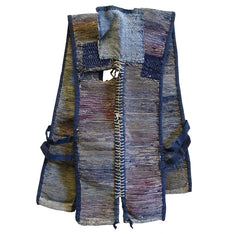A Ragged and Boro Sakiori Sodenashi: Mid Twentieth Century
ca. mid twentieth century
27" x 15 1/4", 68.5 cm x 38.5 cm
This beautifully ragged garment is woven from a rag weft, the technique of rag weaving in Japan being referred to as sakiori, a compound word derived from the verbs to tear and to weave.
This vest is sometimes called sodenashi, which means a garment without sleeves--and as can be seen, it is thickly woven with rags and has been used hard.
Vests like this were good padding when carrying burden or loads, and they also provided a freedom of movement for the arms. You can see by the tabs connecting the front to back areas that this was a garment that was supposed to allow movement of the body.
As well, have a look at the marvelous gusset that bridges the two sides of the sodenashi at its top: it has come undone, but it still bears its beautiful, dense sashiko stitching, the flame stitch representing yabane or the arrow feather motif. Notice, too, the thick, white cotton stitching up the spine of the garment: just lovely.
Obviously this vest has been warn hard as can be seen by the large holes, loose gusset and by its patches, but overall it is a good looking thing and certainly its a vivid reminder of life in old Japan.

